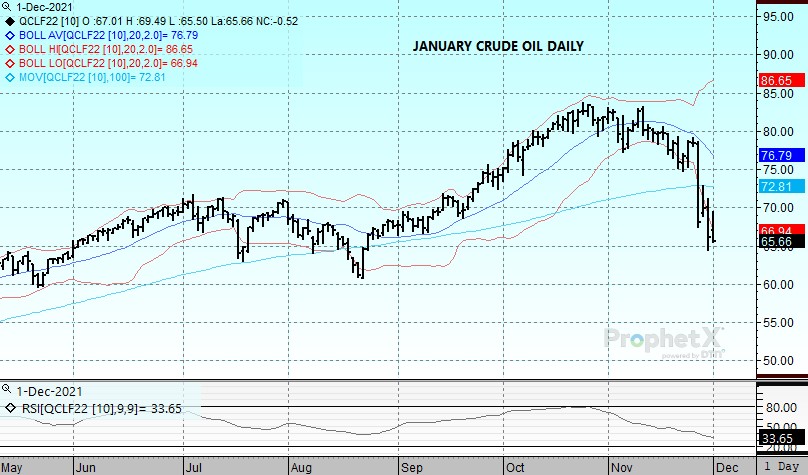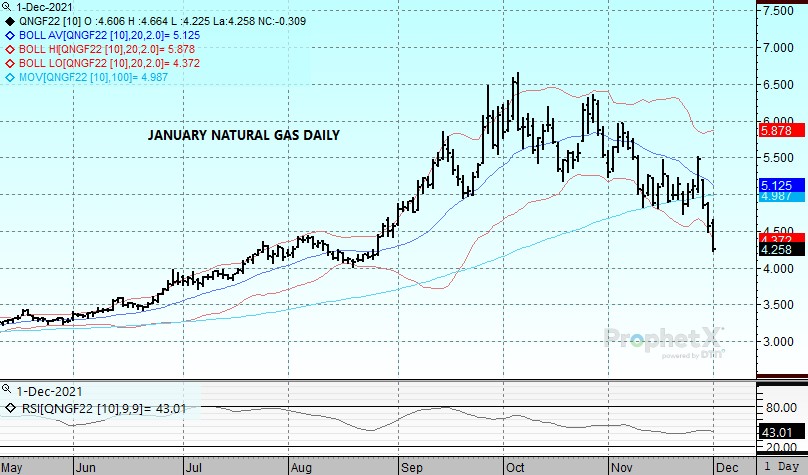Price Overview
The petroleum complex continued to trade in a volatile fashion as the January crude oil stayed within yesterday’s wide range of 71.22-64.33, while the Ultra Low Sulfur Diesel (heating oil) probed as low as 2.0201 yesterday from as high as 2.41 prior to Thanksgiving.
Today’s action appeared to be a pause as participants take stock of where the market stands with respect to the prevailing supply/demand situation amid uncertainty regarding OPEC+ production deliberations that conclude tomorrow. Adding to economic uncertainty and demand potential is the appearance that the Federal Reserve has moved up its schedule for tapering bond purchases, along with questions as to whether the Biden Administration’s efforts at providing additional fiscal stimulus through the Build Back Better bill will pass the Senate. In the background are the related impacts of all the above on dollar direction. At this point it appears that OPEC is unlikely to move dramatically away from their current policy despite the threat to their pricing power from Strategic Reserve releases.
Recognition that spare capacity is limited to mainly Saudi Arabia, UAE and Iraq, and that OPEC+ is having difficulty hitting goals by 700 tb/d during September and October is problematic for the market if the global economy continues to grow. Rising infection rates associated with the Delta variant, concerns about the new Omicron strain, and their impact on economic growth and travel will be key issues driving valuations into the first quarter. Inflationary pressures and the impact that supply chain disruptions have on the world economy could underpin values, while overall effects might not change much since the world has learned to live with and get around disruptions caused by Covid.
Longer term it appears that both structurally and cyclically the world is moving away from a slow growth/low inflation environment to one geared to faster growth and inflation as it confronts challenges posed by environmental, social and governance concerns and worries about global warming. Although the petroleum industry’s spare capacity, estimated at 3-4 mb, is providing some buffer to the market, the prospect of it diminishing over time poses worries that might have an inflationary impact as productivity falls during the transition.
Given the wide scope of issues to be considered on a macro level it is not surprising that the DOE report had little impact. The report continued to indicate low inventory levels, with commercial crude stocks declining by .9 mb despite a release from the SPR of 1.9 mb. Offsetting the decline in crude was the rise in product stocks, with gasoline rising by 4 mb and distillate increasing by 2.2. Surprisingly the cracks strengthened despite the report and increase in refinery utilization to 88.8 percent compared to 78.2 last year and 91.9 percent pre-Covid. From a price standpoint, it looks like 65.00-66.00 basis January crude remains a key support level while resistance likely rests near the 75.00 area, which had been support before Friday’s sharp break.

Natural Gas
The market continued to struggle as the January contract settled at 4.258 for a loss of 31 cents on the day and 1.20 for the week. Weather continues to be the issue as overnight revisions removed another 36 bcf in demand from the 15-day forecasts, with December now expected to produce the second lowest HDD total in the last 20 years. Estimates are pointing to overall storage moving into a surplus to the 5-year average by mid-December. Tomorrow’s report is expected to show a 57 bcf withdrawal verses the 5-year average decrease of 31. The 4.50 support held up for one day, and with the poor close the market now looks determined to test the 4.00 level near term. The 4.50 level now becomes the first level of resistance on a recovery from the overextension on the downside.

The authors of this piece do not currently maintain positions in the commodities mentioned within this report.
Charts Courtesy of DTN Prophet X, EIA, Reuters
Futures and options trading involve significant risk of loss and may not be suitable for everyone. Therefore, carefully consider whether such trading is suitable for you in light of your financial condition. The information and comments contained herein is provided by ADMIS and in no way should be construed to be information provided by ADM. The author of this report did not have a financial interest in any of the contracts discussed in this report at the time the report was prepared. The information provided is designed to assist in your analysis and evaluation of the futures and options markets. However, any decisions you may make to buy, sell or hold a futures or options position on such research are entirely your own and not in any way deemed to be endorsed by or attributed to ADMIS. Copyright ADM Investor Services, Inc.
